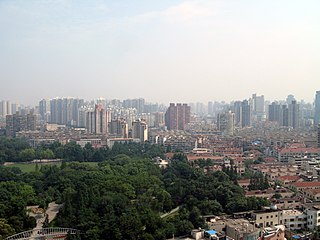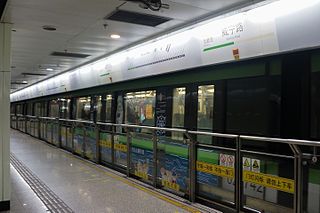
A trolleybus is an electric bus that draws power from dual overhead wires using spring-loaded trolley poles. Two wires, and two trolley poles, are required to complete the electrical circuit. This differs from a tram or streetcar, which normally uses the track as the return path, needing only one wire and one pole. They are also distinct from other kinds of electric buses, which usually rely on batteries. Power is most commonly supplied as 600-volt direct current, but there are exceptions.

Changning is a district of Shanghai, China. It has a land area of 37.19 square kilometres (14.36 sq mi) and had a population of 620,000 as of 2003. The district government is located at 1320 Yuyuan Rd.

A dual-mode bus is a bus that can run independently on power from two different sources, typically electricity from overhead lines like a trolleybus or from batteries like a hybrid bus, alternated with conventional fossil fuel. In contrast to other hybrid buses, dual-mode buses can run forever exclusively on their electric power source (wires). Several of the examples listed below involve the use of dual-mode buses to travel through a tunnel on electric overhead power.

Shanghai has around 2000 formal bus lines, served by more than 10 bus companies. In the past, Bashi, Dazhong, Guanzhong and Qiangsheng were the four largest; around 2009 they merged to become Bashi Group Companies, including Bashi No.1-6 Bus Passenger Service Companies, Bashi Tram, Bashi Xinxin and Chongming Company, Baoshan Company and Jinshan Company. Each Suburban district also renewed with one company serving each district. Around 2015, Bashi No.1 Passenger Service and Bashi Tram merged to be Bashi No.1 Company, Bashi No.2 Passenger Service became Bashi No.2 Company, Bashi No.3, No.4 Passenger Service merged to be Bashi No.3 Company, Bashi No.6 Passenger Service became Bashi No.4 Company, and Bashi No.5 Passenger Service and Baoshan Company became Bashi No.5 Company.

Translohr is a rubber-tyred tramway system, originally developed by Lohr Industrie of France and now run by a consortium of Alstom Transport and Fonds stratégique d'investissement (FSI) as newTL, which took over from Lohr in 2012. It is used in Paris and Clermont-Ferrand, France; Medellín, Colombia; and Venice-Mestre and Padua in Italy. In June 2012, Alstom Group and the Strategic Investment Fund acquired Translohr for €35 million.

Songhong Road is a station on Line 2 of the Shanghai Metro in Changning District. The station served as the western terminus of the line from 30 December 2006, when Line 2 was extended westward from Zhongshan Park, until 16 March 2010, when the second westward extension to the current terminus at East Xujing opened. The station is still often used as a terminus for west-bound trains meaning passengers have to disembark and wait for another train for the remainder of the journey.

Weining Road is a station on Line 2 of the Shanghai Metro in Changning District. It is part of the western extension of that line from Zhongshan Park to Songhong Road that opened on 30 December 2006.

Line 9 is a southwest-northeast line of the Shanghai Metro network. The line runs from Shanghai Songjiang Railway Station in Songjiang District to Caolu in Pudong. The line is colored light blue on system maps.

The Modena trolleybus system forms part of the public transport network of the city and comune of Modena, in the region of Emilia-Romagna, northern Italy.

The Shanghai trolleybus system is a system of trolleybuses forming part of the public transport network in the city of Shanghai, China. Of more than 300 trolleybus systems in operation worldwide, the Shanghai system is the oldest. The system turned 100 years old in November 2014 and was the first trolleybus system anywhere in the world to reach that milestone.

Public bus service in Beijing is among the most extensive, widely used and affordable form of public transportation in urban and suburban districts of the city. In 2015, the entire network consisted of 876 routes with a fleet of 24,347 buses and trolleybuses carried 3.98 billion passengers annually. Trolleybuses run on over 31 routes including 6, 38, 42, 65, 101-112, 114-118, 124, 128, 301, BRT 1-3. Many of these trolleybus routes are located inside the Third Ring Road but some, such as 301 and BRT 1-3, do extend as far out as the Fifth Ring Road. Since 2013, In an effort to reduce urban air pollution, Beijing has been converting regular bus routes to trolleybus routes by installing overhead power lines on several corridors. Public bus service in the city began in 1921. Today there are two operators. The city's primary public bus operator, the state-owned Beijing Public Transport Holdings, Ltd. operates the Bus Service.

Zhengzhou Bus Rapid Transit is a bus rapid transit system in Zhengzhou, the capital of Henan Province in the People's Republic of China. The system has 5 main trunk routes with dedicated bus lanes along with a number of feeder routes that run for a portion of the corridor and serves other areas.

Zhengzhou BRT Route B2 is a bus rapid transit route operated by Zhengzhou Bus. It is the 2nd route with dedicated bus lanes in Zhengzhou BRT.
The Shenyang trolleybus electrocution accident is an overhead power line electrocution accident involving public transport in Shenyang, the capital city of Liaoning province, Northeast China. The accident happened at 15:50 on August 12, 1998, when a trolley pole on a trolleybus stopping at a bus stop in the central Shenhe District slipped off the trolley wires and contacted an uninsulated 11kV high-voltage cable. The vehicle then became electrically charged and electric discharge happened whenever passengers stepped off, resulting in 5 deaths and 9 injuries. This accident had a devastating consequence to the trolleybus operations in Shenyang, ultimately resulting in the complete removal of the city's long-running trolleybus network.

The Yan'an Road Medium Capacity Bus Transit System is a bus rapid transit system operating within Shanghai, China. The network consists of a main route, a partial route and four branch lines, with the main route running between East Yan'an Road & The Bund in Huangpu District and Shenkun Road Bus Terminal in Minhang District via Yan'an Road. The system is operated by Shanghai Bus No.3 Public Transport Co., Ltd., and began trial operations on 1 February 2017.

The BYD B series are a line of battery electric buses produced by Chinese vehicle manufacturer BYD. It is the first bus model powered by BYD's Lithium Iron Phosphate Blade electric-batteries. It is available as a 10-metre single-deck (B10), a 11-metre double-deck bus (BD11), a 12-metre single-deck (B12), a 12-metre tri-axles double-deck (B12D), a 15-metre tri-axles single-deck (B15) and a 18-metre articulated bus (B18).

Trolleybus Route 20 is a trolleybus route in Shanghai, China. It started operations on 27 September 1928, and runs between Zhongshan Park in Changning District and Hankou Road & Middle Sichuan Road in Huangpu District. It is operated by Shanghai Bus No.1 Public Transportation Co. Ltd.

Trolleybus Route 14 is a trolleybus route in Shanghai, China. Having started operations on 15 November 1914, it holds the records of being the first trolleybus route in China, as well as the oldest trolleybus route still in operation worldwide. The route is operated by Shanghai Bus No.1 Public Transportation Co. Ltd, and currently operates between Jiangpu Road & North No.2 Zhongshan Road in Yangpu District and Dongxinqiao in Huangpu District.

Trolleybus route 1 is a trolleybus route in Wuhan, China. Operating since 20 September 1958, it is the first bus route in Wuhan to be operated by trolleybuses. The route currently runs between Jinghan Avenue & Qianjin 1st Road and Shuiguohu Road & Shuiguohu stops, and is operated by Wuhan Public Transport Group Trolleybus Operating Company.

















